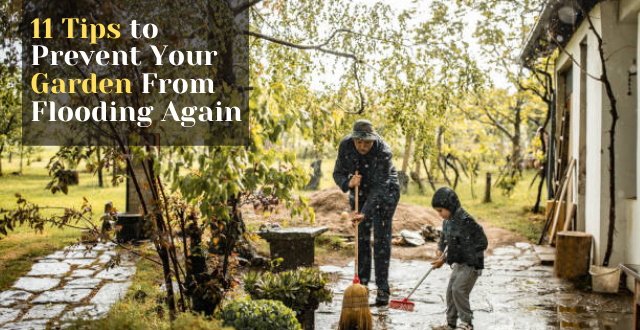How can you recover your garden during stormy weather? Generally, pets and houses come first, but the loss of plants is also devastating for a gardener. Follow these 11 tips to recover a flooded garden and back its former glory.
- Sinkholes
Many sinkholes appear after flooding. Generally, garden communities try to help each other and raise helping hands. Once you check everyone is safe, please help each other to recover quickly.
- Rinse Plants
Do not wait too long; rinse plants within 72 hours of flooding. It is a crucial step because rinsing the plants helps to remove the mud and salt. It also decreases the chances of diseases that spread through cuts and wounds.
- Remove Salt Spray
Please ensure you have washed both the top and bottom of the leaves and completely removed the saltwater and dirt. Excessive saltwater at the bottom of the leaves or plants damages the whole plant. The longer it remains, the greater the damage. Please rinse the plant, and you can start the revival process.
If you think it is a very complex process, you can hire Water Damage Restoration Sydney Experts.
- Clean the Vegetable before Use
Vegetables like melons can be contaminated from the outside and transferred to edible flesh. That is why we promise you to clean it with fresh water before use.
- Use Pump
You can use a pump to remove the standing water because, in most cases, the standing salt water is very harmful to plants and humans. You can use a sump pump for it.
- Spread More Fresh Water
You can spread more fresh water to remove saltwater in the flooded garden. It may seem odd because most of the experts will tell you to remove excess moisture, but we recommend it to dilute the concentration of the pollutants, making the water less harmful for plants even in extreme weather.
- Make Compost
Make a compost pile outside of the garden; it helps you add organic matter to the soil. All the leaves, stems, debris, and mud make the compost pile, which you can use later.
- Do Not Apply Fertilizer
Fertilizer is also composed of salts, so if you use it after flood damage, then it increases the salt in the soil. It would be best if you waited until the plants showed strong growth. Even then, please use the fertilizer as directed or consult with an expert. Excessive use of fertilizer can damage the root of the plants.
- Remove the Damaged Trees
Now you need to find out the damaged trees. Remove the largest trees and shrubs first. Please be careful, and do not cut other plants in the flooded garden. If it is too tough for you, please feel free to hire experts for this task.
- Garden Inspection
After doing all of these, now is the time to inspect the works. You have removed salts and muds, broken trees. Now you have to restore the garden by cutting small branches and broken leaves.
Additionally, please look for new growth. Pruning is the best way of restoration, but it may add additional pressure to other plants and buds.
After initial pruning, you should wait for a week to check new growth, and if you feel you need another pruning, you can do this without affecting the aesthetic quality of the garden.
- Clean the Tub
If you have unused tubs, then cleaning those tubs is easy. However, how can you clean a tub with a plant? The best method is to flush more water to remove the upper layer of salt, and if possible, you should replace the soil.
If the containers are not affected by saltwater, then you can check a few weeks for growth. However, it is better to replace the soil and start again. In this case, you can use fertilizer, expecting the strong growth of plants.
How to Protect Your Garden from Flood Damage?
Saving your garden from floods is a long-term project. You know the weather in your location; why not take some initial steps to prevent flooding?
Please prepare a well-planned drainage system and follow the weather update to prevent it from maximum damage. Besides that, keep contact numbers of local water damage restoration services.
Hire Experts
Most of the homeowners do this alone, but if you love the flowers and plants, you should hire expert services because if you neglect it may spoil the efforts of the last six months of gardening.
Starting from scratch is always an option, but restoring your garden is better than replacing it.
If you need urgent restoration, you can contact our flood damage Sydney experts. They have advanced equipment and eco-friendly materials to provide the best possible result.
Also helping you to remove standing water and all the dirt, broken trees from your lovely garden. Book your appointment now.
 HammBurg Be informed with latest news, reviews, entertainment, lifestyle tips, and much more.
HammBurg Be informed with latest news, reviews, entertainment, lifestyle tips, and much more.




